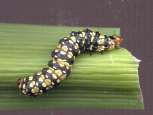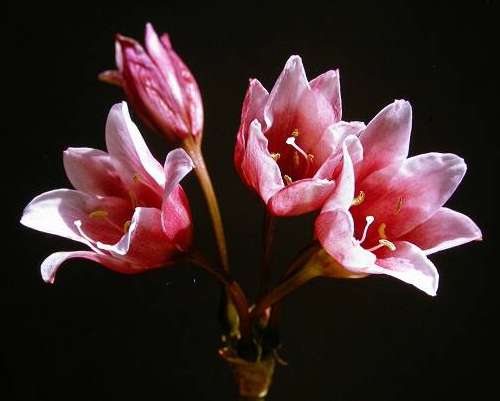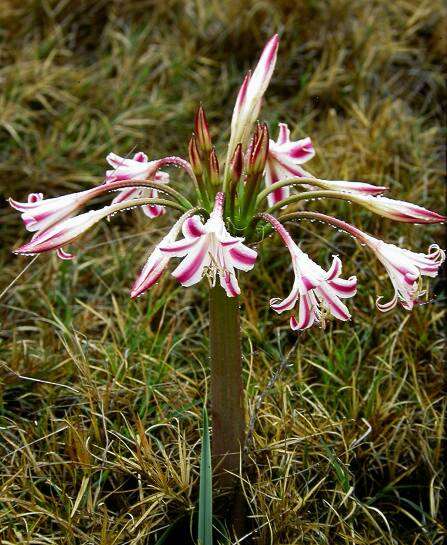Crinum
Crinum L.
Family: Amaryllidaceae
Common names: river lily, veld lily (Eng.); rivierlelie, veldlelie (Afr.); umNduze (Zulu)
Introduction
Crinum is a fascinating genus of the large and equally captivating Amaryllidaceae family. Larger in stature than most other species of Amaryllidaceae, most crinums are suitable as landscape plants in or near water features while most of the smaller species can be successfully cultivated even in a small garden. With due care against their one major pest, crinums are easily cultivated and provide a regular dramatic focus point with their large, bright inflorescences.

Description
Description
The name Crinum originates from the Greek Krinon, which means white lily. As most species have white or whitish flowers the name seems especially appropriate.
Crinum are herbaceous plants with large, tunicated bulbs which produce a neck or a pseudostem made up of the sheathing bases of the old leaves. The leaves are linear to sword-shaped, sheathing at the base, arranged in a rosette or rarely in two opposite rows, often dying back in winter, usually with the previous season's leaves growing out again in spring with a few new leaves in the middle.
The inflorescences arise laterally on a long, solid peduncle (main or inflorescence stalk) and are umbellate (flower stalks radiate from one central point), with two spathe valves (bracts) and one to many flowers. The flowers have short or long stalks with a long perianth tube and linear to broadly lanceolate segments that are spreading or held together in a trumpet shape. The stamens are either curved, ascending or angled downwards. The ovary appears as a swelling between the flower stalk and the tube.

The fruit are subglobose, sometimes beaked, with the persistent remains of the tube bulging with large seeds and eventually bursting irregularly to release the seeds. The seeds are subglobose, with a more or less impervious, smooth or distinctly hairy seed coat.
Distribution and habitat
Distribution description
There are between 60 and 100 species of Crinum world-wide, occurring in America, Africa, southern Asia to Australia. Africa has the most species. The genus is related to a group of mostly southern African endemic genera, constituting the tribe Amaryllideae (Meerow & Snijman 1998). Twenty-two species are at present recognized in southern Africa. The uncertainty about the number of species is due to the difficulty in correctly naming species. Crinum are particularly difficult to assess from dried herbarium sheets. Species previously thought to be just one variable species may consist of a number of distinct species. Thus even recent literature uses different names for the same species (Lehmiller 1997).
There are two main groups of species, sometimes placed in subgenera in older literature.
- In the first group, the flowers are radially symmetrical, with slender or linear segments; it is cosmopolitan and is closely associated with large seasonally flooded habitats or a few species may even be permanently submerged in water.
- The second group, those with a wide, funnel-shaped form and bilaterally symmetrical flowers, is mostly restricted to Africa, with a few in India and Australia. These species occur in a range of habitats from pans or riverbanks, arid regions to hill slopes or forest margins. Despite the frequent arid habitats where crinums are found, they respond well to water and flower in masses after the often brief rainfall period in a area. The seeds are well adapted for water dispersal and this has clearly been responsible for the cosmopolitan distribution of the genus.
Recent molecular analysis does not support this classification into two groups as outlined above. (Meerow et al 2003).
Ecology
Ecology
As discussed above, crinums occur in a wide range of habitats from aquatic to desert. Each species is adapted to its specific habitat and this should be taken into account by the gardener.
Uses
Use
Crinum species have a long history of cultivation. Many northern hemisphere hybrids have been attempted of which one, Crinum x powellii (presumably a cross between C. bulbispermum and C. moorei) is still often seen in older southern African gardens. Yet there is still much scope for the selection and development of cultivars in the genus. Micropropagation is now a successful option for large-scale propagation of many species of Crinum e.g. the rare C. variabile (Fennell et al. 2001).
Throughout the world Crinum species have been used traditionally to cure ailments and diseases. Phytochemical analysis yielded more than 150 different isoquinoline or Amaryllidaceae alkaloids and some of the most noted effects are analgesic, anticholinergic, antitumour and antiviral. Recently, galanthamine has been registered as an acetylcholinesterase inhibitor, which is an important approach in treating Alzheimer's disease (Jäger et al. 2004). Since the alkaloids are highly toxic, use of Crinum species is not recommended for the novice, as a large dose could easily be fatal.
Growing Crinum
Grow
Stock of most true species rarely multiplies vegetatively by forming offsets. If it does, it is probably a hybrid. It is best cultivated from seed. Seeds are placed in a well-drained, sandy medium with plenty of compost and a slow-release fertilizer such as bonemeal, with regular watering and full sun. The high water content of the seed enables it to germinate after a week or two, even in dry conditions. Seed germination is hypogeal: the embryo stem is formed soon after release and in turn produces the cotyledon and radicle below the soil surface. Check to see that the young bulb is not pushed out of the soil. If seedlings are kept growing throughout the winter months, they will reach flowering size sooner. First flowering can be expected after three (C. macowanii) to eight years (C. graminicola). The plants perform best in a permanent position and, like any Amaryllidaceae, do not react well to any disturbance of the roots
In the garden most species will grow well in any soil to which plenty of compost has been added. C. campanulatum needs to be placed in a pot in water. Plants grow best in full sun but will tolerate light shade and will thrive in a wet part of the garden. C. moorei does well under trees and is a most useful species for the 'dry shade' problem. The plants will benefit greatly from occasional feeding with liquid fertilizer and compost added to the growing medium.

Because of its poisonous alkaloids, its only real pest is the specifically adapted black-and-yellow-striped amaryllis caterpillar (Brithys pancratii) and occasionally snails and slugs, which may render especially the thin-leaved species an unsightly mess in a short time. However, the bulbs of large plants are seldom entirely destroyed by the caterpillars and new leaves grow out quickly. A broad-spectrum insecticide containing a modern pyrethrin can be used. In a garden, the amaryllis caterpillar often necessitates regular spraying in summer.
Virus-infested plants, especially from large or retail nurseries can be a problem and should be checked carefully for any symptoms. Unfortunately it is not easy to distinguish between viruses and some fungal diseases and any suspect plants should be destroyed to stop the virus from spreading by root disturbance or insects. Basal stem rot occasionally infects the plants but can be treated with fungicides.
The following species are selected as they are more commonly seen in South Africa or are considered more suitable for cultivation. However, a number of other South African or tropical species (Bryan 2002), are also worth cultivating for their unusual appearance, e.g. C. buphanoides (distichous leaves), C. minimum (an unusual dwarf species, Craib 1997), C. variabile (a winter rainfall species, Fennell et al. 2001), C. asiaticum (an attractive variegated form is available) and C. jagus (superficial similarity to C. moorei).
Species

C. acaule
A dwarf species with a umbel of one or two (rarely three), comparatively large and fleshy flowers that are strongly scented. The peduncles are underground and therefore the fruit are usually partially buried. The segments are white, with a pink flush, usually keeled with deep pink. The fruit is beaked and the seeds are large, blackish and distinctly papillose. It is a rare endemic to Zululand in KwaZulu-Natal. The puzzling relationships between this species and similar Namibian species needs to be re-examined critically (Archer 1997; Archer & Condy 1999a).

C. bulbispermum orange river lily (Eng.), oranjerivierlelie (Afr.)
Frequently confused with C. macowanii in nurseries, the leaves are greyish green and not the brighter green or less glaucous (pale bluish green) colour characteristic of the latter species. One of the largest of the South African species, the bulb is very large and the sheathing leaves usually form a thick false stem up to 400 mm long, glaucous green. Flowers 5 to 16, the perianth segments form a narrow funnel shape with the apical portion slightly recurved, white with a dark red keel or uniformly pinkish, becoming red as the flowers fade. It occurs on the Highveld of South Africa: Gauteng, Mpumalanga, Free State as well as along the Orange River in the Northern Cape. They can survive high temperatures in summer and well below freezing in winter. This species is very variable in size and particularly in the length of the perianth segments. Some plants with short segments are not at all attractive.

C. campanulatum vleilelie (Afr.)
One of the true aquatic species that needs to be placed under water to flower. Flowers few, up to seven. The perianth is funnel-shaped, segments are white to uniform light pink, becoming deep red in the fading flower. Endemic to a small area in the Eastern Cape.

C. graminicola graslelie (Afr.)
Closely related to C. stulmannii and differs mainly in that its fruit develops faster and is usually beaked. The peduncle is usually relatively short and spreading. Flowers are usually a uniform deep pink colour but many plants have flowers that are white with a prominent, deep pink keel. This species is unusually slow to mature, a minimum of eight years should be expected and it flowers irregularly. Described from Gauteng and the North-West province it also occurs in the northern parts of KwaZulu-Natal. Plants from Limpopo and Botswana may belongs to this species or to C. stuhlmanii.

C. lugardiae veld lily (Eng.); veldlelie (Afr., Du Plessis & Duncan 1989)
Despite its recorded common name, the species is more often recorded in areas adjacent to vleis or areas subjected to brief seasonal flooding. It is an easily grown species (though slow-growing), but adapts well and flowers regularly in a garden. C. lugardiae is smaller, but similar in appearance to C. macowani and they are sometimes confused. Distribution is from Gauteng to Namibia.

C. macowanii Sabie crinum, Cape coast lily (Eng.) umNduze (Zulu)
Particularly suitable for use as a landscape or garden plant. It is probably the easiest species to cultivate owing to the large number of seeds produced and plants can flower within three years in optimum conditions. When flowering between October and December, the large inflorescences with up to 25 large white flowers present a spectacular display (Archer & Condy 1999b).

C. moorei Natal lily (Eng., Du Plessis & Duncan 1989), boslelie (Afr.)
A tall plant with its almost evergreen leaves emerging from a thin pseudostem, is horticulturally most suitable for any garden. This is the only one of the South African species which grows and matures new leaves each season, therefore the leaf tips are neat and not truncated as in the other species. Five to ten flowers are born on a long, erect peduncle. The perianth segments are white or pale pink and form a very wide open funnel, adding to its attraction. In addition, the species prefers shade. In most highveld gardens leaves die off after March and emerge early in July. Flowers emerge in late summer, but plants from Port St Johns in the Eastern Cape are recorded as flowering in September (Batten 1986). It is possible that many of these plants are finding their way into gardens, and plants can now be seen flowering throughout the rainy season. The species occurs in Eastern Cape and KwaZulu-Natal.

C. paludosum
A smaller plant often found in large numbers in vleis. The vlei on the Sandhof Farm in Namibia is a small natural wonder when a million plants are in flower simultaneously. It has a scattered distribution from KwaZulu-Natal and Mozambique, to Namibia. The leaves are light green and gracefully arch outwards 'like young mealies'. Flowers 5 to 11, white to pink, sometimes with a darker pink keel.

C. stuhlmannii candy-striped crinum (Hesse 2001)
Until recently known as C. delagoense or C. forbesii (Archer & Archer 1996; Lehmiller 1997). The species occurs from KwaZulu-Natal to East Africa along the coastal region and along the low-altitude Zambezi and Limpopo Valleys. The species is similar to C. graminicola but with a long erect peduncle and with numerous (up to 30) flowers. The perianth segment usually has a prominent deep pink keel which gave origin to the above-mentioned common name. The fruit is not beaked and the pericarp is thick and fleshy, eventually turning bright red.
References
- Archer, R.H. 1997. Crinum acaule, C. minimum, and C. parvibulbosum in southern Africa. Herbertia 52: 90-94.
- Archer, R.H. & Archer, C. 1996. Should Crinum forbesii (Lindl.) Schult. & Shult. f. be reinstated? Bothalia 26: 153.
- Archer, R.H. & Condy, C. 1999a. Crinum acaule. Flowering Plants of Africa 56: 36-40.
- Archer, R.H. & Condy, C. 1999b . Crinum macowanii. Flowering Plants of Africa 56: 30-35.
- Batten, A. 1986. Flowers of southern Africa. Frandsen, Sandton.
- Bryan, J. 2002. Bulbs. Timber Press, Portland.
- Craib, C. 1997. Crinum minimum: one of south Africa's most unusual bulbous plants. Herbertia 52: 101-108.
- Du Plessis, N. & Duncan, G. 1989. Bulbous plants of southern Africa. Tafelberg, Cape Town.
- Fennell, C.W. 2001. Micropropagation of the River Lily, Crinum variabile (Amaryllidaceae). South African Journal of Botany 67: 74-77.
- Hesse, G. 2001. The crinums in my garden. Veld & Flora 87: 136.
- Jäger, A.K., Adsersen, A. & Fennell, C.W. 2004. Acetylcholinesterase inhibition of Crinum sp. South African Journal of Botany 70: 323-325.
- Lehmiller, D.J. 1997. Synopsis of the genus Crinum (Amaryllidaceae) in Namibia. Herbertia 52: 44-65.
- Meerow, A.W. & Snijman, D.A. 1998. Amaryllidaceae. In: K. Kubitzki, Families and genera of vascular plants, vol. 3: 83-110. Springer-Verlag, Berlin.
- Meerow, A.W., Lehmiller, D.J. & Clayton, J.R. 2003. Phylogeny and biogeography of Crinum L. (Amaryllidaceae) inferred from nuclear and limited plastid non-coding DNA sequences. Botanical Journal of the Linnean Society 141: 349-363.
Credits
Robert H. Archer
National Herbarium, Pretoria
September 2004
Plant Attributes:
Plant Type: Bulb
SA Distribution:
Soil type:
Flowering season:
PH:
Flower colour:
Aspect:
Gardening skill:
Special Features:
Horticultural zones






Rate this article
Article well written and informative
Rate this plant
Is this an interesting plant?
Login to add your Comment
Back to topNot registered yet? Click here to register.